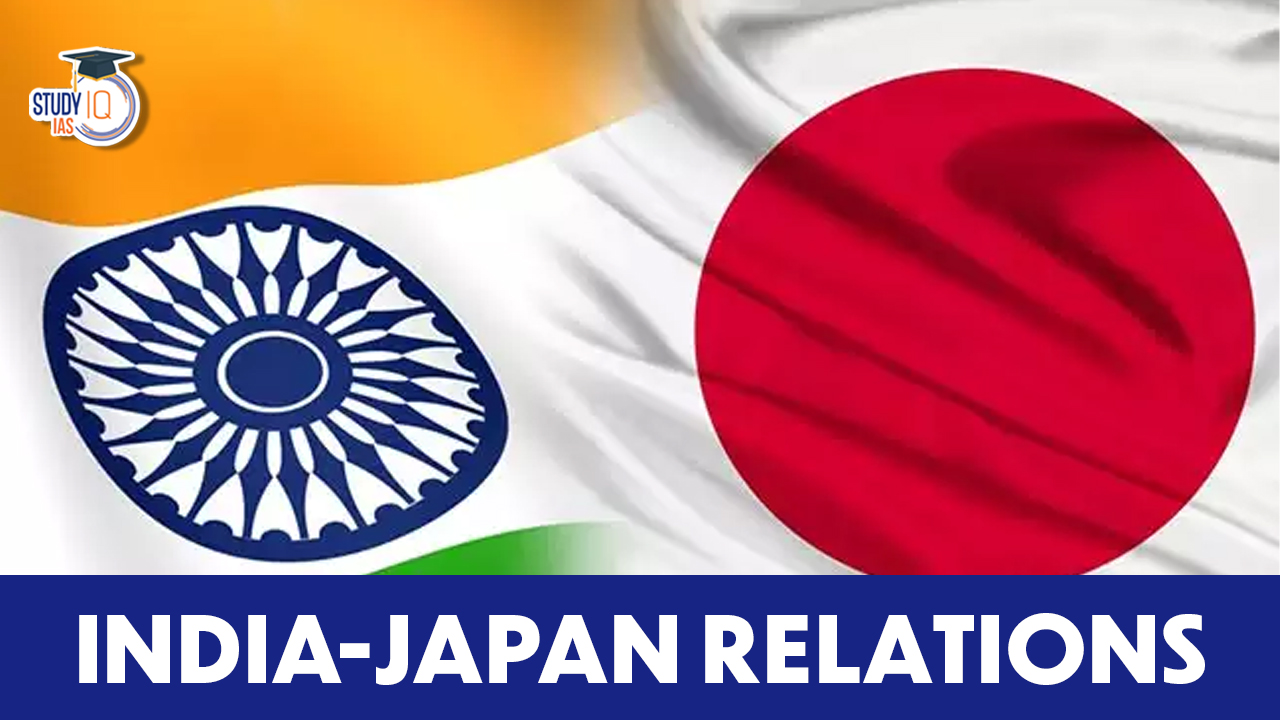Table of Contents
Context: Indian External Affairs Minister has emphasized the importance of enhancing India-Japan partnership and collaboration in various areas, including economics, supply chains, digital technology, and maritime security.
More on News
Current Scenario:
- India and Japan prioritize peacetime cooperation: Both countries have a strong focus on strengthening their cooperation during peacetime rather than explicitly discussing their actions in the event of conflicts, particularly involving the Taiwan Strait or the Line of Actual Control (LAC) between India and China.
- India and Japan as “natural partners”: The two countries view themselves as “natural partners” and acknowledge the challenges posed by the evolving global order. They aim to enhance their partnership and collaboration in various domains, including economics, supply chains, digital technology, critical technologies, and maritime security.
- Japan’s role in India’s modernization: Japan has been an “exemplar modernizer” and a role model for India. Japan is known for its industrial initiatives in India, such as the Maruti-Suzuki collaboration, Metro rail services, and high-speed rail projects like the Mumbai-Ahmedabad Shinkansen project.
- India-Japan Strategic Dialogue and investment commitment: The two countries held their 15th annual India-Japan Foreign Ministers’ Strategic Dialogue, where they recommitted to a 5-trillion yen target for Japanese investment in India between 2022 and 2027.
- Japan’s Indo-Pacific policy and focus on India: Japan’s new Indo-Pacific policy places special emphasis on ties with India, including cooperation on projects in third countries like Sri Lanka and Bangladesh.
- Alignment of G-7 and G-20 priorities: Japan expresses interest in aligning its G-7 presidency goals with India’s G-20 priorities, with a specific focus on involving the Global South.
Evolution of India-Japan Ties

Areas of Cooperation
- Economic and Commercial Cooperation:
- A Comprehensive Economic Partnership Agreement (CEPA) has been in place between India and Japan since 2011, which has contributed to an increase in bilateral trade.
- Japan has been one of the largest investors in India, with over $35 billion of foreign direct investment (FDI) in the past 20 years, primarily in sectors such as automobiles, electrical equipment, telecommunications, chemicals, and pharmaceuticals.
- Furthermore, Japan is the largest bilateral donor to India, providing Japanese Official Development Assistance (ODA) for major infrastructure projects like the Delhi-Mumbai Industrial Corridor and the Ahmedabad-Mumbai High-Speed Rail Link.
- In response to the supply chain disruptions caused by Covid-19, India and Japan are collaborating with Australia on the Supply Chains Resilience Initiative (SCRI).
- Strategic Cooperation:
- India and Japan have been collaborating with Germany and Brazil for permanent membership of the United Nations Security Council (UNSC) as part of the G4 or Group of Four.
- The 2+2 Dialogue, which includes discussions between the foreign and defence ministers of both nations, has led to an expansion of defence and strategic cooperation that extends beyond national boundaries.
- Additionally, the Quadrilateral Security Dialogue (Quad) between India, the United States, Japan, and Australia is aimed at promoting a Free and Open Indo-Pacific.
- Japan welcomes the Indo-Pacific Ocean’s Initiative (IPOI) announced in 2019 at East Asia Summit (EAS) in Bangkok for promoting safe, secure, and stable maritime domain, sustainable use of marine resources, and disaster prevention and management.
- Defence cooperation:
- Naval Exercises: JIMEX (started in 2012), Malabar (started by India and US in 1992 with Japan becoming permanent member in 2015)
- Army Exercise: Dharma Guardian (started in 2018)
- Air Force Exercise: Shinyuu Maitri (started in 2018)
- Skill Development:
- Japan and India have been collaborating to promote manufacturing in India through the establishment of Japan India Institute of Manufacturing (JIM) centres.
- These centres were set up to provide technical education and training to students in various fields of manufacturing, such as electronics, automotive, and robotics.
- As of 2021, there are 12 JIM centres in India, located in various states such as Gujarat, Rajasthan, and Tamil Nadu.
- Furthermore, Japan has pledged to train 30,000 Indian youth in Japanese-style manufacturing techniques over the next 10 years.
- This initiative is part of the Japan-India Technical Intern Training Program (TITP), which aims to provide Indian youth with practical training and work experience in Japan.
- Nuclear Energy:
- Following a temporary pause and economic sanctions on India after its nuclear tests in 1998, the country resumed its cooperation with Japan in the peaceful use of nuclear energy in 2017.
- Both nations signed an agreement that resulted in increased collaboration in energy security and clean energy, facilitated the commissioning of global nuclear reactors using Japanese components, and supported India’s bid for membership in the Nuclear Suppliers Group (NSG).
- S&T /Space Cooperation:
- In 2019, the first-ever space dialogue between India and Japan was held to explore opportunities for bilateral cooperation in space.
- Currently, the Indian Space Research Organization (ISRO) and the Japan Aerospace Exploration Agency (JAXA) are collaborating on a joint lunar polar exploration (LUPEX) mission to send a lander and rover to the Moon’s south pole by 2024.
- Additionally, the India-Japan Digital Partnership (I-JDP) was launched in 2018 to build upon the science and technology collaboration established in 1985 and focus on digital ICT technologies to foster innovation and entrepreneurship in the digital sector.
- ‘India-Japan Emerging Technology and Innovation Fund’ was established in 2019, a fund-of-funds for emerging technology startups in Internet of Things (IoT), Artificial Intelligence (AI), Machine Learning etc.
- Historical & Cultural Relations:
- Since the first Cultural Agreement in 1957, cultural relations between India and Japan have continued to flourish through friendly exchanges and increased people-to-people contact.
- The historical ties between the nations can be traced back to the 6th century when Buddhism was first introduced to Japan.
- The influence of Indian culture, transmitted through Buddhism, has had a significant impact on Japanese culture, and this has fostered a sense of affinity between the Japanese people and India.
Challenges in India-Japan Relations
- Bilateral Trade Imbalance: The trade ties between India and Japan have not developed as much as India’s trade relations with China. The low share of Japan in India’s imports and exports, compared to China, remains a significant issue.
- Chinese Factor: Some critics view the India-Japan relationship as driven by concerns about China’s rise rather than genuine mutual interests. They argue that the cooperation should be based on shared interests in areas like trade and technology.
- Delayed Projects: Despite progress in economic cooperation, certain projects such as the Asia-Africa Growth Corridor and the Mumbai-Ahmedabad Bullet train face delays and weak economic engagements.
- Barriers for Indian Exports: India encounters barriers in penetrating Japanese markets due to factors like language differences and high quality service standards, which need to be addressed to boost cooperation.
- Diverging Interests: India’s decisions on trade issues like exiting from the trade pillar of the Indian-Pacific Economic Framework (IPEF) and the Regional Comprehensive Economic Partnership (RCEP) differ from Japan’s stance, which can create challenges in finding common ground.
- China’s Influence: Both India and Japan have border and hegemonic issues with China, leading to their policy stances often being influenced by China’s actions, which can impact their overall relationship.
- Balancing QUAD and BRICS: India’s membership in groups like BRICS and its participation in the Asian Infrastructure Investment Bank (AIIB) require a delicate balancing act between its engagement in the QUAD alliance and other multilateral forums involving China.
- Asia-Africa Growth Corridor (AAGC) Scepticism: There is scepticism about the feasibility and nature of projects within the Asia-Africa Growth Corridor, which can affect the overall effectiveness of this initiative.
- Lopsided Trade and Geopolitics: Correcting the trade imbalance and addressing issues related to political, territorial, and water disputes with China is crucial to prevent Beijing from leveraging its economic influence against India.


 TNPSC Group 4 Admit Card 2025 Out at tnp...
TNPSC Group 4 Admit Card 2025 Out at tnp...
 Species Added to India's Flora and Fauna...
Species Added to India's Flora and Fauna...
 Daily Quiz 02 July 2025
Daily Quiz 02 July 2025





















